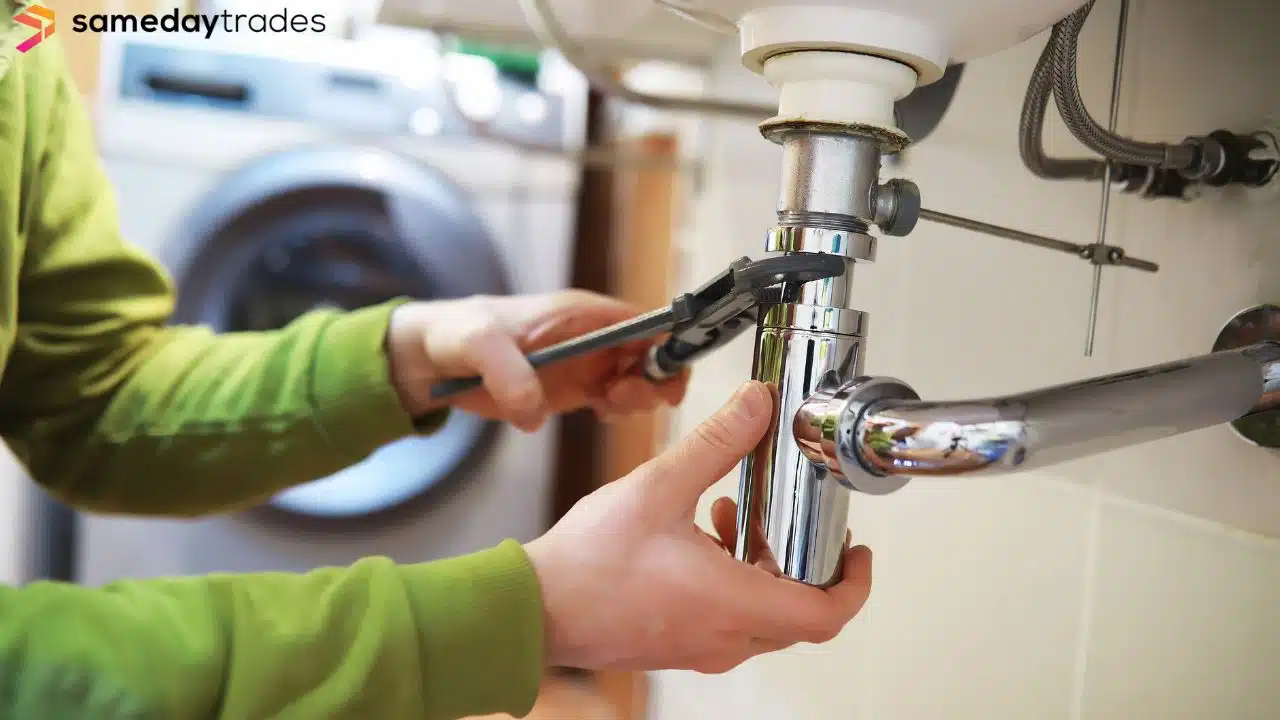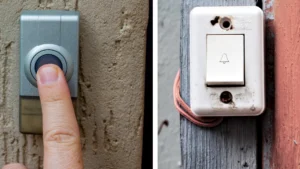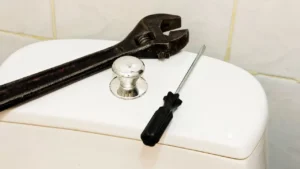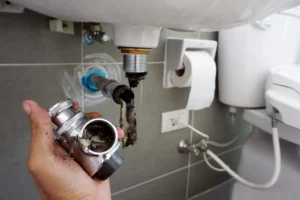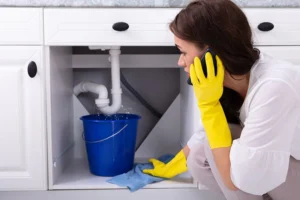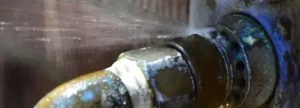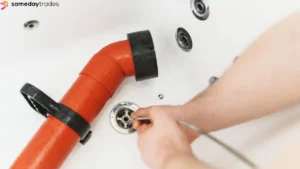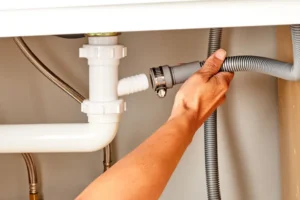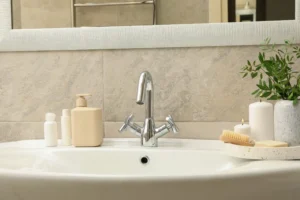Blocked drains are a headache no one wants. They cause foul smells, slow water flow, and even bigger problems if ignored. This guide shares 10 simple ways to clear blocked drains using tools and home remedies.
Ready to fix that clogged drain?
Signs of a Blocked Drain
Blocked drains can be sneaky troublemakers. They often show warning signs that scream for attention!
Foul smells
Bad smells often come from drains clogged with decomposing food or rotting debris. It can smell like sewage, making your home unbearable.
These odours are red flags of a blocked drain. Grease, oils, or soap scum build up and rot over time inside pipes. Ignore this too long and the stink only gets worse!
Slow draining water
Water hanging around the sink or tub is trouble. A blocked drain could be slowing it down. Sinks, showers, and bathtubs often show this issue first. It’s like a queue of water waiting for its turn to leave.
This delay happens when debris blocks the normal flow in pipes.
Clogged drains caused by grease, hair, or soap can worsen over time if left unchecked. Kitchen sinks with leftover food scraps are top culprits for clogs too. The longer it takes for water to drain completely, the more serious your blockage might be—don’t wait too long before trying to unclog it!
Gurgling sounds
Gurgling sounds in a drain usually mean trapped air is trying to escape. This happens due to blockages in your pipes or drains, like grease, hair, or debris clogging the flow. These noises often come from sinks, toilets, or tubs.
Such sounds can signal a partially clogged drain pipe. Ignoring these could lead to worse clogs and potential water blockage. It’s best to deal with the issue early before it turns into a fully blocked drainage system!
Common Causes of Blocked Drains
Blocked drains don’t just happen out of nowhere—they’ve got their culprits. Everyday habits and nature’s little surprises can cause big headaches.
Cooking grease and oils
Grease and oil harden in pipes, mixing with food scraps to form stubborn clogs. Pouring these down your sink can cause serious blockage deeper inside the plumbing.
Collect used cooking oils and let grease cool before tossing them into the bin. This prevents drain clogging while protecting your pipes from costly repairs. Avoid rinsing oily pans directly under water—wipe them first with a paper towel to keep drains flowing smoothly!
Hair and soap scum
Hair clogs drains like nothing else. Strands tangle with other debris, creating stubborn knots inside pipes. Soap scum worsens this issue by sticking to hair and pipe walls, making the blockage thicker over time.
Solid soap bars often slip into sinks or showers, lodging in tight spaces and causing extra trouble.
This mess builds up fast—especially in shower or bathroom drains. Long hair sheds daily during washes, mixing with oily residues from shampoos or body washes. Over weeks, it forms a sticky plug that slows water flow and traps more grime.
Clearing these blocks needs immediate action before they harden deeply inside pipes!
Tree roots and natural debris
Tree roots break into drains searching for water, causing blockages. These roots can grow deeply and enter cracks in pipes. Over time, they create clogged pipes that need fixing fast.
A blocked drain plumber may be needed for severe cases if home remedies fail.
Leaves, twigs, and dirt easily gather in outdoor drains after rain or storms. This natural debris piles up and creates a drainage clog. Unblocking drains like this often needs tools like a wet vacuum or high-pressure water jets to clear the mess quickly.
10 Tips to Clear Any Blocked Drain
Got a blocked drain? These ten simple tips can help you sort it out, so grab your tools and get started!
Boiling water
Pour boiling water directly into the blocked drain. The heat melts grease and dissolves stubborn debris, making it easier to clear drains. This simple method works best for kitchen sink blockages caused by fats or oils.
Avoid pouring boiling water into PVC pipes. High heat can weaken or warp them, leading to more damage. Use this as a home remedy for clogged drains safely on metal pipes only.
Baking soda and vinegar
Mix 1 cup of bicarbonate of soda with 1 cup of vinegar. Pour the mixture down the clogged drain. It will fizz and bubble, breaking down grime and debris. Let it sit for 10 minutes to work its magic.
Flush the drain with hot water after the wait time. This helps push loosened clogs through the pipe. It’s a simple, eco-friendly way to unblock drains at home without harsh chemicals!
Use a plunger
A plunger works wonders to unblock a drain. It creates a strong vacuum effect that dislodges local blockages. Place the rubber cup over the blocked drain firmly, covering it fully.
Push down gently, then pull up quickly several times. This motion builds pressure to move the clog.
Plungers are cheap and easy to use. For better results, add water around the plunger’s base to seal air gaps. Whether it’s a blocked kitchen sink or clogged bathroom drain, this budget-friendly tool saves time and hassle!
DIY drain snake
Grab a metal coat hanger and straighten it. Bend one end to make a small hook. This DIY drain snake can pull out blockages like hair from drains. Push the hooked end into the clogged pipe, twist it gently, and start fishing out debris.
It’s cheap and super simple for clearing a clogged drain deep in the pipe. Use gloves to avoid touching gunk directly. For stubborn blockages, repeat until water flows freely again!
Wet and dry vacuum
A wet and dry vacuum can be a lifesaver for drain unclogging. It sucks out stubborn blockages from deep in the pipe using powerful suction. Switch it to “wet” mode, seal the hose tightly over your clogged drain, and let it do its magic.
Even a kitchen sink blocked with grease or debris stands no chance against this tool.
This method is budget-friendly and effective for clearing tricky drains. Unlike other options, you don’t need harsh chemicals or fancy gadgets. Use it to clean up water spills around blocked drains as well! It’s simple, safe, and gets the job done quickly.
Caustic drain cleaner
Caustic drain cleaners work fast to dissolve grease, oils, and stubborn clogs. They contain strong chemicals like sodium hydroxide or potassium hydroxide. These break down tough blockages deep in pipes.
Use them only for serious clogs, like a clogged drainage line or blocked kitchen sink drain.
Always read the label carefully before use. Wear gloves and open windows for ventilation to avoid fumes. Never mix caustic cleaners with other products; it can create dangerous reactions.
If using on outside drains filled with natural debris, double-check compatibility first. For heavily clogged drains that won’t budge, this option might save you a call to a plumber!
Professional drain snake
A professional drain snake is a powerful tool to clear stubborn blockages. It can remove clogs deep in pipes that home remedies may miss. Plumbers use these snakes to cut through grease, hair, or roots blocking drains.
They are long and flexible with a metal coil on the end.
This method works well for tough clogs like blocked sewage drains or clogged drain lines. A plumber inserts the snake into the pipe and rotates it to break up debris. If your clogged sink drain keeps returning, this could be the solution you need!
High-pressure water jetting
Powerful water jets blast through blockages with ease. Pressures can reach up to 4000 psi, strong enough to cut through grease, roots, and built-up debris stuck deep in pipes. This method unclogs drains efficiently and clears grime from pipe walls.
It works well for major clogs but isn’t cheap. Older pipes risk damage under such high pressure, so handle carefully or consult a blocked drains plumber.
CCTV drain camera inspection
CCTV drain camera inspections use a tiny waterproof camera to find blockages deep in pipes. This tool shows exactly where and what the problem is without digging or guessing. It’s perfect for diagnosing stubborn clogged drains or hard-to-reach pipe issues.
The footage helps locate debris, tree roots, or even damaged pipes that need repair. Professionals often recommend this method if common home remedies don’t work. It saves time, prevents bigger damage, and avoids unnecessary costs from trial-and-error methods like plungers or chemicals.
Pipe relining
Pipe relining fixes damaged pipes without digging. A flexible tube coated with resin slides into the broken pipe. Once placed, it hardens to form a new solid lining inside the old pipe.
This method can repair cracks, leaks, and other damage in sewer or drainage lines quickly.
It’s ideal for deep clogs or blocked drains caused by tree roots. Professional help is often needed since precise tools like CCTV drain cameras guide the process. Pipe relining saves time, avoids major disruptions and lasts for years—a modern solution to tricky plumbing problems!
Conclusion
Cleaning a blocked drain doesn’t have to feel like climbing a mountain. With the right tools and tips, you can tackle most clogs with ease. From boiling water to professional help, there’s always a way out of the mess.
Act quickly when you notice signs of trouble, and keep those pipes happy with regular care! Your drains will thank you—no more gurgles or slow flow!
FAQs
How can I unclog a drain at home?
You can try pouring hot water down the drain, using a plunger, or applying a blocked drain cleaner to clear simple blockages.
What should I do if my kitchen sink is clogged?
If your kitchen sink is clogged, start by removing any visible debris from the drain and use a plunger or vinegar and baking soda as a home remedy.
How do you unblock a sink with water still in it?
To unblock a sink with standing water, try using a plunger first. If that doesn’t work, carefully remove the trap under the sink to check for clogs.
Can I fix deep pipe blockages myself?
For deep pipe blockages, you might need tools like an auger or plumber’s snake to reach further into the pipes and dislodge the clog.
What causes drains to get blocked outside?
Blocked outside drains often happen due to leaves, dirt buildup, or grease solidifying in pipes over time.

